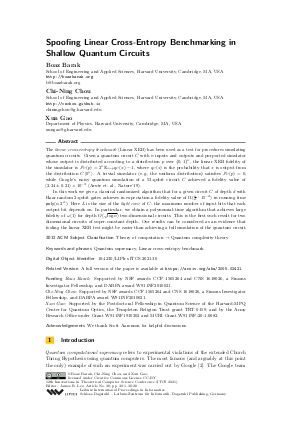Spoofing Linear Cross-Entropy Benchmarking in Shallow Quantum Circuits
Authors Boaz Barak, Chi-Ning Chou, Xun Gao
-
Part of:
Volume:
12th Innovations in Theoretical Computer Science Conference (ITCS 2021)
Part of: Series: Leibniz International Proceedings in Informatics (LIPIcs)
Part of: Conference: Innovations in Theoretical Computer Science Conference (ITCS) - License:
 Creative Commons Attribution 3.0 Unported license
Creative Commons Attribution 3.0 Unported license
- Publication Date: 2021-02-04
File

PDF
LIPIcs.ITCS.2021.30.pdf
- Filesize: 0.64 MB
- 20 pages
Document Identifiers
Related Versions
-
A full version of the paper is available at https://arxiv.org/abs/2005.02421.
Subject Classification
ACM Subject Classification
- Theory of computation → Quantum complexity theory
Keywords
- Quantum supremacy
- Linear cross-entropy benchmark
Metrics
- Access Statistics
-
Total Accesses (updated on a weekly basis)
0PDF Downloads0Metadata Views
Abstract
The linear cross-entropy benchmark (Linear XEB) has been used as a test for procedures simulating quantum circuits. Given a quantum circuit C with n inputs and outputs and purported simulator whose output is distributed according to a distribution p over {0,1}ⁿ, the linear XEB fidelity of the simulator is ℱ_C(p) = 2ⁿ 𝔼_{x ∼ p} q_C(x) -1, where q_C(x) is the probability that x is output from the distribution C |0ⁿ⟩. A trivial simulator (e.g., the uniform distribution) satisfies ℱ_C(p) = 0, while Google’s noisy quantum simulation of a 53-qubit circuit C achieved a fidelity value of (2.24 ±0.21)×10^{-3} (Arute et. al., Nature'19).
In this work we give a classical randomized algorithm that for a given circuit C of depth d with Haar random 2-qubit gates achieves in expectation a fidelity value of Ω(n/L⋅15^{-d}) in running time poly(n,2^L). Here L is the size of the light cone of C: the maximum number of input bits that each output bit depends on. In particular, we obtain a polynomial-time algorithm that achieves large fidelity of ω(1) for depth O(√{log n}) two-dimensional circuits. This is the first such result for two dimensional circuits of super-constant depth. Our results can be considered as an evidence that fooling the linear XEB test might be easier than achieving a full simulation of the quantum circuit.
Cite As Get BibTex
Boaz Barak, Chi-Ning Chou, and Xun Gao. Spoofing Linear Cross-Entropy Benchmarking in Shallow Quantum Circuits. In 12th Innovations in Theoretical Computer Science Conference (ITCS 2021). Leibniz International Proceedings in Informatics (LIPIcs), Volume 185, pp. 30:1-30:20, Schloss Dagstuhl – Leibniz-Zentrum für Informatik (2021)
https://doi.org/10.4230/LIPIcs.ITCS.2021.30
BibTex
@InProceedings{barak_et_al:LIPIcs.ITCS.2021.30,
author = {Barak, Boaz and Chou, Chi-Ning and Gao, Xun},
title = {{Spoofing Linear Cross-Entropy Benchmarking in Shallow Quantum Circuits}},
booktitle = {12th Innovations in Theoretical Computer Science Conference (ITCS 2021)},
pages = {30:1--30:20},
series = {Leibniz International Proceedings in Informatics (LIPIcs)},
ISBN = {978-3-95977-177-1},
ISSN = {1868-8969},
year = {2021},
volume = {185},
editor = {Lee, James R.},
publisher = {Schloss Dagstuhl -- Leibniz-Zentrum f{\"u}r Informatik},
address = {Dagstuhl, Germany},
URL = {https://drops.dagstuhl.de/entities/document/10.4230/LIPIcs.ITCS.2021.30},
URN = {urn:nbn:de:0030-drops-135699},
doi = {10.4230/LIPIcs.ITCS.2021.30},
annote = {Keywords: Quantum supremacy, Linear cross-entropy benchmark}
}
Author Details
Funding
- Barak, Boaz: Supported by NSF awards CCF 1565264 and CNS 1618026, a Simons Investigator Fellowship, and DARPA award W911NF2010021.
- Chou, Chi-Ning: Supported by NSF awards CCF 1565264 and CNS 1618026, a Simons Investigator Fellowship, and DARPA award W911NF2010021.
- Gao, Xun: Supported by the Postdoctoral Fellowship in Quantum Science of the Harvard-MPQ Center for Quantum Optics, the Templeton Religion Trust grant TRT 0159, and by the Army Research Office under Grant W911NF1910302 and MURI Grant W911NF-20-1-0082.
Acknowledgements
We thank Scott Aaronson for helpful discussions.
References
- Scott Aaronson and Sam Gunn. On the classical hardness of spoofing linear cross-entropy benchmarking. arXiv preprint, 2019. URL: http://arxiv.org/abs/1910.12085.
-
Frank Arute, Kunal Arya, Ryan Babbush, Dave Bacon, Joseph C Bardin, Rami Barends, Rupak Biswas, Sergio Boixo, Fernando GSL Brandao, David A Buell, et al. Quantum supremacy using a programmable superconducting processor. Nature, 574(7779):505-510, 2019.

-
Michael J Bremner, Ashley Montanaro, and Dan J Shepherd. Average-case complexity versus approximate simulation of commuting quantum computations. Physical review letters, 117(8):080501, 2016.

-
Michael J Bremner, Ashley Montanaro, and Dan J Shepherd. Achieving quantum supremacy with sparse and noisy commuting quantum computations. Quantum, 1:8, 2017.

-
PW Brouwer and CWJ Beenakker. Diagrammatic method of integration over the unitary group, with applications to quantum transport in mesoscopic systems. Journal of Mathematical Physics, 37(10):4904-4934, 1996.

- Xun Gao and Luming Duan. Efficient classical simulation of noisy quantum computation. arXiv preprint, 2018. URL: http://arxiv.org/abs/1810.03176.
- Nicholas Hunter-Jones. Unitary designs from statistical mechanics in random quantum circuits. arXiv preprint, 2019. URL: http://arxiv.org/abs/1905.12053.
- John Napp, Rolando L La Placa, Alexander M Dalzell, Fernando GSL Brandao, and Aram W Harrow. Efficient classical simulation of random shallow 2d quantum circuits. arXiv preprint, 2019. URL: http://arxiv.org/abs/2001.00021.
- Kyungjoo Noh, Liang Jiang, and Bill Fefferman. Efficient classical simulation of noisy random quantum circuits in one dimension. arXiv preprint, 2020. URL: http://arxiv.org/abs/2003.13163.
-
Guifré Vidal. Efficient simulation of one-dimensional quantum many-body systems. Physical review letters, 93(4):040502, 2004.

- Man-Hong Yung and Xun Gao. Can chaotic quantum circuits maintain quantum supremacy under noise? arXiv preprint, 2017. URL: http://arxiv.org/abs/1706.08913.
- Yiqing Zhou, E Miles Stoudenmire, and Xavier Waintal. What limits the simulation of quantum computers? arXiv preprint, 2020. URL: http://arxiv.org/abs/2002.07730.
